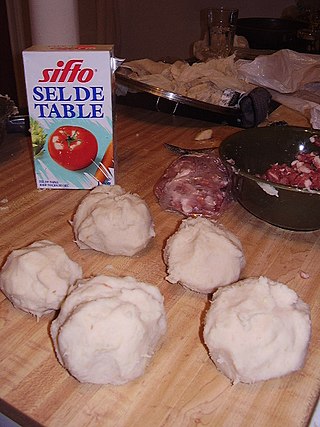
The cuisine of the Southern United States encompasses diverse food traditions of several subregions, including cuisine of Southeastern Native American tribes, Tidewater, Appalachian, Ozarks, Lowcountry, Cajun, Creole, African American cuisine and Floribbean, Spanish, French, British, and German cuisine. In recent history, elements of Southern cuisine have spread to other parts of the United States, influencing other types of American cuisine.

Thai cuisine is the national cuisine of Thailand.

Vietnamese cuisine encompasses the foods and beverages originated from Vietnam. Meals feature a combination of five fundamental tastes : sweet, salty, bitter, sour, and spicy. The distinctive nature of each dish reflects one or more elements, which are also based around a five-pronged philosophy. Vietnamese recipes use ingredients like lemongrass, ginger, mint, Vietnamese mint, long coriander, Saigon cinnamon, bird's eye chili, lime, and Thai basil leaves. Traditional Vietnamese cooking has often been characterised as using fresh ingredients, not using much dairy or oil, having interesting textures, and making use of herbs and vegetables. The cuisine is also low in sugar and is almost always naturally gluten-free, as many of the dishes are rice-based instead of wheat-based, made with rice noodles, papers and flour.

Australian cuisine is the food and cooking practices of Australia and its inhabitants. Australia has absorbed culinary contributions and adaptations from various cultures around the world, including British, European, Asian and Middle Eastern.

The Komi are an Indigenous Permian ethnic group whose homeland is in the northeast of European Russia around the basins of the Vychegda, Pechora and Kama rivers. They mostly reside in the Komi Republic, Perm Krai, Murmansk Oblast, Khanty–Mansi Autonomous Okrug, and Yamalo-Nenets Autonomous Okrug in the Russian Federation.

A samosa from the Persian word Sambosag (سنبوسگ) is a fried South Asian and West Asian snack. It is a pastry with a savory filling, mostly vegetables, spiced potatoes, onions, peas, also non-vegetarian meat, or fish. It is made into different shapes, including triangular, cone, or crescent, depending on the region. Samosas are often accompanied by chutney, and have origins in medieval times or earlier. Sweet versions are also made. Samosas are a popular entrée, appetizer, or snack in the cuisines of India, South Asia, West Asia, Central Asia, East Africa and their South Asian diasporas.

Russian cuisine is a collection of the different dishes and cooking traditions of the Russian people as well as a list of culinary products popular in Russia, with most names being known since pre-Soviet times, coming from all kinds of social circles.
Latvian cuisine typically consists of agricultural products, with meat featuring in most main dishes. Fish is commonly consumed due to Latvia's location on the eastern shore of the Baltic Sea.

Chayote or Sicyos edulis, also known as christophine, mirliton and choko, is an edible plant belonging to the gourd family, Cucurbitaceae. This fruit was first cultivated in Mesoamerica between southern Mexico and Honduras, with the most genetic diversity available in both Mexico and Guatemala. It is one of several foods introduced to the Old World during the Columbian Exchange. At that time, the plant spread to other parts of the Americas, ultimately causing it to be integrated into the cuisine of many Latin American nations.
Serbian cuisine is a Balkan cuisine that consists of the culinary methods and traditions of Serbia. Its roots lie in Serbian history, including centuries of cultural contact and influence with the Greeks and the Byzantine Empire, the Ottomans, and Serbia's Balkan neighbours, especially during the existence of Yugoslavia. Historically, Serbian food develops from pastoral customs that involved the keeping of sheep in mountain highlands, in a climate and regional context that favoured animal husbandry over vegetable farming; Serbian food is therefore traditionally richer in animal products and basic grains—corn, wheat and oats—than fresh vegetable dishes. Following the abandonment of widely practiced pastoral lifestyles, Serbian food emerged through the Middle Ages heavily dependent not on lamb or mutton, but on the keeping of pigs for the annual cull and the production of various cured meats, such as sausages, bacon and ham products.

Ghanaian cuisine refers to the meals of the Ghanaian people. The main dishes of Ghana are centered around starchy staple foods, accompanied by either a sauce or soup as well as a source of protein. The primary ingredients for the vast majority of soups and stews are tomatoes, hot peppers, and onions. As a result of these main ingredients, most Ghanaian jollof rice, soups, and stews appear red or orange.

Tatar cuisine is primarily the cuisine of the Volga Tatars, who live in Tatarstan, Russia, and surrounding areas.

Chilean cuisine stems mainly from the combination of traditional Spanish cuisine, Chilean Mapuche culture and local ingredients, with later important influences from other European cuisines, particularly from Germany, the United Kingdom and France. The food tradition and recipes in Chile are notable for the variety of flavours and ingredients, with the country's diverse geography and climate hosting a wide range of agricultural produce, fruits and vegetables. The long coastline and the peoples' relationship with the Pacific Ocean add an immense array of seafood to Chilean cuisine, with the country's waters home to unique species of fish, molluscs, crustaceans and algae, thanks to the oxygen-rich water carried in by the Humboldt Current. Chile is also one of the world's largest producers of wine and many Chilean recipes are enhanced and accompanied by local wines. The confection dulce de leche was invented in Chile and is one of the country's most notable contributions to world cuisine.

Nigerian cuisine consists of dishes or food items from the hundreds of Native African ethnic groups that comprises Nigeria. Like other West African cuisines, it uses spices and herbs with palm oil or groundnut oil to create deeply flavored sauces and soups.
Bermudian cuisine blends British and Portuguese cuisine with preparations of local seafood species, particularly wahoo and rockfish. Traditional dishes include codfish and potatoes served either with an add-on of hard-boiled egg and butter or olive oil sauce with a banana or in the Portuguese style with tomato-onion sauce, peas and rice. Hoppin' John, pawpaw casserole and fish chowder are also specialties of Bermuda. As most ingredients used in Bermuda's cuisine are imported, local dishes are offered with a global blend, with fish as the major ingredient, in any food eaten at any time.

Pirog is a baked case of dough with either sweet or savory filling. The dish is common in Eastern European cuisines.

Traditional Yamal cuisine is an important part of national culture of the Nenets, Khanty and Komi. Yamal is a hunting and fishing land so many dishes include meat, fowl and fish. Berries and mushrooms are also abundant; this accounts for the wealth of "gifts of the forests" on the Yamal table. Presently, Yamal cuisine is renowned for diverse delicacies of Russian cuisine. Yamal hosts enjoy treating their guests with traditional Yamal cuisine and have hot tea which came to Yamal cuisine from Russia. Tea has become the national Yamal beverage, drunk to warm and soothe. Yamal is in northern Russia with frigid winters, so its cuisine should be nourishing to give the people energy to survive during the long winter time. The essential component of Yamal cuisine is warm and hot dishes. Fresh fruits and vegetables are rarely used as they must be imported, as they are not grown in the tundra. The Yamal cuisine is associated with malosol and stroganina. Yamal cuisine has absorbed techniques from other regions. Yamal cuisine is based on reindeer meat and fish of the Yamal rivers, enriched with mushrooms and bread.

Acadian cuisine comprises the traditional dishes of the Acadian people. It is primarily seen in the present-day cultural region of Acadia.Note 1 Acadian cuisine has been influenced by the Deportation of the Acadians, proximity to the ocean, the Canadian winter, bad soil fertility, the cuisine of Quebec, American cuisine, and English cuisine, among other factors.

Khanom chin or Khanom jeen are fresh, thin rice noodles in Thai cuisine which are made from rice sometimes fermented for three days, boiled, and then made into noodles by extruding the resulting dough through a sieve into boiling water. Khanom chin is served in many kinds of stock: coconut milk, fish curry, and chilli.

Sakha cuisine encompasses the customary and traditional cooking techniques and culinary arts of Sakha.















